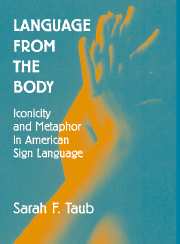Book contents
- Frontmatter
- Contents
- List of Figures
- Acknowledgments
- 1 A Glimpse of the Material
- 2 Motivation and Linguistic Theory
- 3 Iconicity Defined and Demonstrated
- 4 The Analogue-Building Model of Linguistic Iconicity
- 5 Survey of Iconicity in Signed and Spoken Languages
- 6 Metaphor in American Sign Language: The Double Mapping
- 7 Many Metaphors in a Single Sign
- 8 The Vertical Scale as Source Domain
- 9 Verb Agreement Paths in American Sign Language
- 10 Complex Superposition of Metaphors in an American Sign Language Poem
- 11 The Future of Signed-Language Research
- Appendix 1 Glossing Conventions
- Appendix 2 Translation of “The Treasure”
- References
- Index
8 - The Vertical Scale as Source Domain
Published online by Cambridge University Press: 16 October 2009
- Frontmatter
- Contents
- List of Figures
- Acknowledgments
- 1 A Glimpse of the Material
- 2 Motivation and Linguistic Theory
- 3 Iconicity Defined and Demonstrated
- 4 The Analogue-Building Model of Linguistic Iconicity
- 5 Survey of Iconicity in Signed and Spoken Languages
- 6 Metaphor in American Sign Language: The Double Mapping
- 7 Many Metaphors in a Single Sign
- 8 The Vertical Scale as Source Domain
- 9 Verb Agreement Paths in American Sign Language
- 10 Complex Superposition of Metaphors in an American Sign Language Poem
- 11 The Future of Signed-Language Research
- Appendix 1 Glossing Conventions
- Appendix 2 Translation of “The Treasure”
- References
- Index
Summary
MULTIPLE USES OF A SINGLE SOURCE DOMAIN
Conceptual metaphors are pairings of source and target conceptual domains. When discussing a metaphor, we must always specify both the source and the target domain, for a very good reason: A language may use the same source domain to describe many different target domains, and it may describe a single target domain using many different source domains. Each of these source–target pairings has a distinct mapping and should be treated as a separate conceptual metaphor. It makes little sense to talk about English's fire metaphors, for example, as a coherent group. English uses fire as a source domain for concepts such as life, desire, destruction, and anger; the target domains differ greatly, and each source–target pairing draws on different aspects of the fire domain.
In this section, we will go through several ASL metaphors that use the same source domain: the vertical up–down scale (cf. Sweetser 1995 for vertical-scale metaphors in English, Brennan 1990 for some BSL examples). As each source–target pairing is analyzed, we will see that they fall into two types: the “positive-end-up” type and the “positive-end-down” type. Moreover, each pairing's use of the vertical scale is different and is motivated by a different set of experiences in the world. The positive-end-up mappings are based on two different kinds of experience: the fact that piles of objects become taller when more objects are added, and the fact that height or high ground gives one an advantage in a physical confrontation.
Information
- Type
- Chapter
- Information
- Language from the BodyIconicity and Metaphor in American Sign Language, pp. 138 - 158Publisher: Cambridge University PressPrint publication year: 2001
